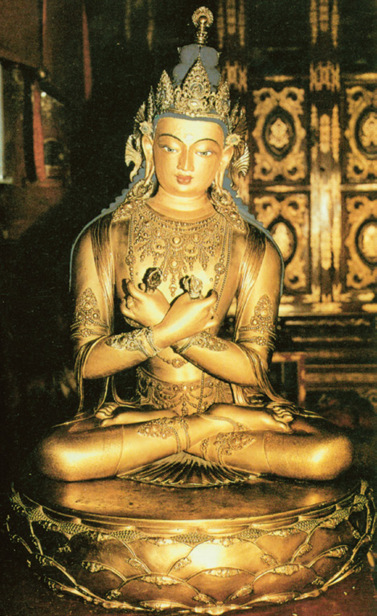An Illustrated Outline of Buddhism: The Essentials of Buddhist Spirituality (16 page)
Read An Illustrated Outline of Buddhism: The Essentials of Buddhist Spirituality Online
Authors: William Stoddart,Joseph A. Fitzgerald
Tags: #Philosophy

Prayer” in Eastern Christianity, and
dhikr Allāh
(the “remembrance of
God”) in Islam. In Buddhism, the spiritual method of invocation or re-
membrance is known as
Buddhānusmriti
(Sanskrit),
nien-fo
(Chinese),
and
nembutsu
(Japanese).
*
* *
A well-known Buddhist doctrine is that of
anātmā
(Pali
anattā
),
“non-
self”. This is said to be one of the “three conditions of existence” (
trilak-
shana
),
namely:
impermanence (
anitya
)
suffering (
duhkha
)
non-self (
anātmā
)
It is important to understand that the doctrine of
anātmā
is
not a
denial of
Ātmā
(Self), as is commonly supposed. It simply tel s us that
creatures, to the extent that they are subject to the “three poisons” (il-
lusion, lust, pride), are devoid of
Ātmā
.
By the same token, those who,
thanks to the revealed means of grace, have overcome il usion and pas-
sion—either real y or virtual y—have established (or are establishing)
themselves in
Ātmā
.
In Christian terms, “the kingdom of Heaven is
within you”. One must immediately add that to misunderstand this
latter doctrine is the most lethal of spiritual poisons. To equate the
unregenerate soul with the Divine is precisely the central flaw of “new
age” ideology.
3
Stations of Wisdom
(London: John Murray, 1961) p. 144.
Opposite page
:
Sukhāvatī
, the Western Paradise of Amitābha, Tibet, 18th century

44
An Illustrated Outline of Buddhism
In the famous incident when the Buddha met a group of people
searching for a young woman (the symbol of
anātmā
,
“non-self”),
he said to them: “What think ye? Were it not better that ye sought
the Self?” [
attānam gaveseyyātha
] (
Vinaya Pitaka
, i,
23). The Buddha made many references to the Self (
Ātmā
):
“Make the Self your refuge”
(
Samyutta Nikāya
, iii,
143). “Be such as have the Self as your refuge”
(
Dīgha Nikāya
, ii,
101). “I have made the Self my refuge” (
Dīgha Nikāya
, ii,
120). The “Self”,
Ātmā
(which in fact amounts to “God Immanent”,
the Nirvanic Reality), is as central to Buddhism as it is to Hinduism
and other religions.
Again in the
Dīgha-Nikāya
(iii, 84), the
Tathāgata
is said to be
“
Brahma-
become” and “
Dhamma
-become”, which clearly underscores
the equation of the
Tathāgata
(the Buddha) with
Brahma
(the Supreme
Divinity),
Dhamma
(the Law or Norm)—as well as with
Ātmā
(the
Self). (See also
Samyutta-Nikāya
,
iii, 120, quoted on the next page.)
There is a parallel to the Buddhist doctrine of “non-self” (
anattā
)
in the Judeo-Christian Scripture. Only God can say: “I am that I am”.
Only
Ātmā
is ful y and truly real. It is recorded that Christ said to St.
Catherine of Siena in a vision: “Thou art she who is not; I am He who
is.” St. Catherine herself said: “I find no more
me
;
there is no longer
any other
I
but God.” St. Paul proclaimed the same truth, when he said:
“Not I, but Christ in me.” The Christian teaching, like the Buddhist,
makes clear the merely relative reality of al that is not Absolute, and is
a necessary doctrinal prelude to spiritual endeavor.
In Islam also there is a parallel, and this is in the declaration of
faith: “there is no god but God”. Some of the Islamic mystics, or Su-
fis, interpret this basic dogma in a manner that is in complete accord
with Buddhist doctrine, namely, “there is no reality but the one Real-
ity”, which amounts to saying “there is no self but the Self”. They also
speak of the need for “extinction” (
fanā’
)
of the lower soul (
nafs
)
and of “permanence” (
baqā’
)
in God. Buddhist spiritual teaching lays the
emphasis on the emptiness (
anattā
)
of the lower soul; only the
arhant
(the saint who has overcome
samsāra
and achieved
Nirvāna
)
is ful y
“awakened”, ful y “
Dhamma
-become”.
Paraphrasing Molière, we can say that there is emptiness and emp-
tiness, as well as fullness and fullness: there is the vain fullness of the
world (
samsāra
)
and the sacred Emptiness of the Void (
Shūnyatā
);
at the same time there is the vain emptiness of the unregenerate soul
(
anattā
)
and the sacred Fullness of the Self (
Ātmā
).



Vajradhara Buddha, Mongolia, 17th century

46
An Illustrated Outline of Buddhism
Just as Christianity has its roots, not in creation but in the Creator,
so Buddhism has its roots, not in
samsāra
(the “il usory”, the decep-
tive) but in
Nirvāna
(the Real, the True), variously referred to, in dif-
ferent contexts, as
Dharma
(“Law”, “Norm”, “Truth”),
Bodhi
(“Enlight-
enment”, “Knowledge”), and
Ātmā
(“Self”).
Buddhism’s message for
suffering man is that herein alone lies “release from suffering” or, as
Christianity would say, salvation.
Let it be said here that metaphysics is
not
absent from Buddhism;
Buddhism is not merely a methodology, as is sometimes alleged. The
efficacy of its method is based on the truth of its doctrine. Anything
else would be inconceivable.
*
* *
As mentioned on p. 23, Buddhism, like Hinduism and Christianity, is
“incarnationist” and “iconodulic”. Buddha not only teaches doctrine—
“turns the Wheel (
chakra
)
of the Law (
dharma
)”—but actual y incar-
nates
Nirvāna
.
The image of the Buddha—of supernatural origin—is
of profound sacramental importance in Buddhist spirituality. In this
connection, it is said: “The Buddha also teaches by means of his super-
human beauty.”
*
* *
In Christianity, much importance is given to the doctrine of the
Logos
. In
fact, the doctrine of the
Logos
(whatever name it be given) is central to ev-
ery religion, for the
Logos
is the indispensable link between man and God.
Within each religion, the Founder is the personification of the
Lo-
gos
, and his role as such is always made explicit. Christ said: “No man
cometh to the Father but by me.” Mohammed said: “No one will meet
God who has not first met His Prophet”, and also: “He that hath seen
me (the Prophet), hath seen the Truth (God).” In Buddhism, it is strik-
ingly similar: the Buddha said: “He who sees the
Dhamma
sees me,
and he who sees me sees the
Dhamma
”
(
Samyutta-Nikāya
, iii,
120).
It is precisely this identification with the
Logos
which enables and
requires each Founder (Prophet or
Avatāra
)
to speak in such absolute
terms. Were it not so, there would be no question of a religion, nor
would there be any possibility of salvation.
Opposite page
: Phra Buddha Jinnarat of Pitsanulok, Thailand, 15th century

